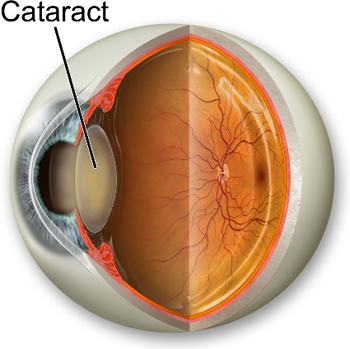Cataract Center

About Your Eyes and Cataracts
In order to see clearly, it is necessary for light to be able to pass freely through the Cornea and the Crystalline Lens, which are the two main optical components of your eyes. The Cornea and the Crystalline Lens are responsible for refracting, or bending light so that it can focus properly on the back of the eye, or the Retina. The Cornea is the outermost clear curved “lens” that is visible when looking at your eye from a side view. The Crystalline Lens is located behind the colored part of the eye, or the Iris, and is not directly visible. The Crystalline Lens will be examined during your eye examination at Riverside Eye Center in Lewiston and Norway, by using specialized instruments to look through the Pupil, or the dark center of the Iris. Both the Cornea and the Crystalline Lens need to be perfectly clear in order for you to have good vision. If you are in good health and have not had chronic eye infections, inflammation or had any trauma to your eyes, the Cornea is likely to maintain its clarity throughout your life. The Crystalline Lens however undergoes a number of changes that progress as we age. These aging changes can affect your vision.
Usually by about the time we reach the age of 40 years old, most of us begin to experience some of the visual effects that result from changes in the Crystalline Lens. Even if you have had “good eyes” and “normal vision” all your life, your vision is likely to begin to change in a number of ways. As we progress from our 40’s, to our 50’s and then our 60’s and beyond, the most obvious changes to our vision occur as a result of these changes in the Crystalline Lens.
The two most common changes that occur in the Crystalline Lens are:
- A loss of flexibility, called Presbyopia, which makes it harder to read and
- A loss of optical clarity, called cataract.

About Presbyopia
Presbyopia begins at around age 40 and progresses until about age 65. Until approximately the age of 40, the crystalline lens is soft and flexible permitting it to change its shape and alter its curvature so that it can help focus your vision at various distances-from far, to near, to arms length, to far or near again. This flexibility gives you the ability to see things at all distances.
Around the time we enter our 40’s, the crystalline lens begins to stiffen making it progressively more difficult to change focus and thus to see clearly at all distances. Often, this reduces our ability to see objects clearly at arms length or up close. When the gradual loss of flexibility of the crystalline lens occurs, it is called Presbyopia or “old eyes”. Presbyopia is a normal and expected consequence of growing older and it affects everyone. Patients beginning Presbyopia will often find their “arms are too short”, and they need to move near objects and reading material farther away in order to bring them into focus and see them clearly.
When Presbyopia begins people who have never worn eyeglasses find that they need reading glasses or bifocals in order to read and see up close. People who already wear glasses may need bifocals or trifocals in order to see comfortably up close. It is important to note that Presbyopia affects everyone including those who have cataracts.

Cataracts and Driving
Cataracts can interfere with your ability to drive safely and comfortably. A Cataract can cause glare sensitivity in both bright and dark conditions and can even cause halos around lights for night driving. In addition to the glare and halo problem there is another night driving problem called “night myopia”. In dim lighting, and especially at night, we lose the ability to accurately maintain our focus. This may be due to the fact that under dim or dark lighting conditions, the pupil of our eyes dilates and become larger causing a decrease in our “depth of focus”. This phenomenon occurs regardless of age but may be more significant as we get older and especially for those who have Cataracts. In addition, the ability to see well in low contrast situations, such as night driving, is critical in seeing lane markers, curbs, barriers and objects in the road. Cataracts reduce your ability to see in low contrast. All in all, driving at night with a Cataract can be a challenge. According to the study reported in Archives of Ophthalmology in 2001, older drivers with Cataracts have poor low contrast vision and thus have 2.5 times greater motor vehicle collision risk than those without Cataracts.
If you think that you may be developing a Cataract or have been told that you have Cataracts, please feel free to discuss any difficulty that you might be experiencing with night vision problems and driving problems with Dr. Whitaker. Dr. Whitaker and the staff at Riverside Eye Center will take the time necessary to carefully evaluate your individual situation so that he can most effectively help you determine the best time to have Cataract Surgery and Intraocular Lens (IOL) Implantation so as to maintain your lifestyle and avoid any undue safety issues while driving. You can schedule your consultation today by contacting us at any of our two convenient locations in Lewiston and Norway Maine.
